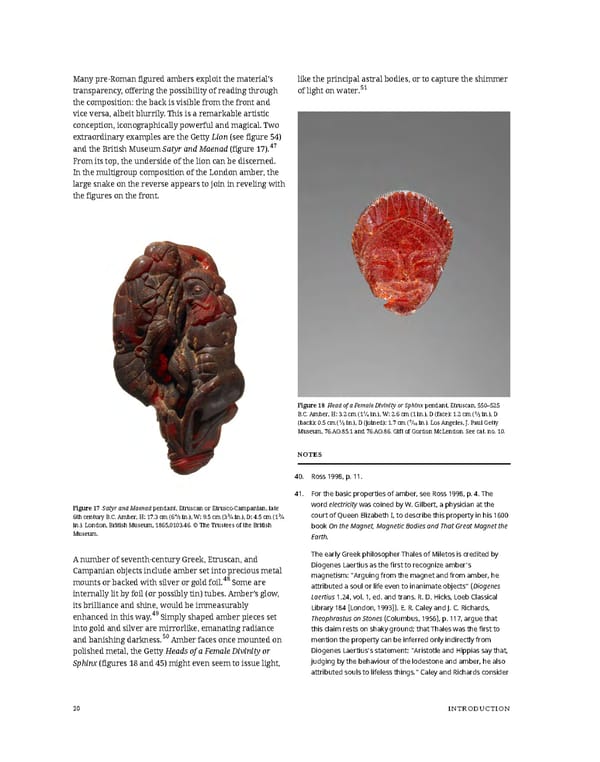Many pre-Roman figured ambers exploit the material’s like the principal astral bodies, or to capture the shimmer transparency, offering the possibility of reading through of light on water.51 the composition: the back is visible from the front and vice versa, albeit blurrily. This is a remarkable artistic conception, iconographically powerful and magical. Two extraordinary examples are the Getty Lion (see figure 54) and the British Museum Satyr and Maenad (figure 17).47 From its top, the underside of the lion can be discerned. In the multigroup composition of the London amber, the large snake on the reverse appears to join in reveling with the figures on the front. Figure 18 Head of a Female Divinity or Sphinx pendant, Etruscan, 550–525 B.C. Amber, H: 3.2 cm (11⁄4 in.), W: 2.6 cm (1 in.), D (face): 1.2 cm (2⁄5 in.), D (back): 0.5 cm (1⁄5 in.), D (joined): 1.7 cm (7⁄10 in.). Los Angeles, J. Paul Getty Museum, 76.AO.85.1 and 76.AO.86. Gift of Gordon McLendon. See cat. no. 10. NOTES 40. Ross 1998, p. 11. 41. For the basic properties of amber, see Ross 1998, p. 4. The Figure 17 Satyr and Maenad pendant, Etruscan or Etrusco-Campanian, late wordelectricity was coined by W. Gilbert, a physician at the 6th century B.C. Amber, H: 17.3 cm (64⁄5 in.), W: 9.5 cm (33⁄4 in.), D: 4.5 cm (13⁄4 court of Queen Elizabeth I, to describe this property in his 1600 in.). London, British Museum, 1865,0103.46. © The Trustees of the British bookOn the Magnet, Magnetic Bodies and That Great Magnet the Museum. Earth. A number of seventh-century Greek, Etruscan, and The early Greek philosopher Thales of Miletos is credited by Campanian objects include amber set into precious metal Diogenes Laertius as the first to recognize amber’s mounts or backed with silver or gold foil.48 Some are magnetism: “Arguing from the magnet and from amber, he internally lit by foil (or possibly tin) tubes. Amber’s glow, attributed a soul or life even to inanimate objects” (Diogenes Laertius 1.24, vol. 1, ed. and trans. R. D. Hicks, Loeb Classical its brilliance and shine, would be immeasurably Library 184 [London, 1993]). E. R. Caley and J. C. Richards, enhanced in this way.49 Simply shaped amber pieces set Theophrastus on Stones (Columbus, 1956), p. 117, argue that into gold and silver are mirrorlike, emanating radiance this claim rests on shaky ground; that Thales was the first to and banishing darkness.50 Amber faces once mounted on mention the property can be inferred only indirectly from polished metal, the Getty Heads of a Female Divinity or Diogenes Laertius’s statement: “Aristotle and Hippias say that, Sphinx(figures 18 and 45) might even seem to issue light, judging by the behaviour of the lodestone and amber, he also attributed souls to lifeless things.” Caley and Richards consider 20 INTRODUCTION
 Ancient Carved Ambers in the J. Paul Getty Museum Page 29 Page 31
Ancient Carved Ambers in the J. Paul Getty Museum Page 29 Page 31